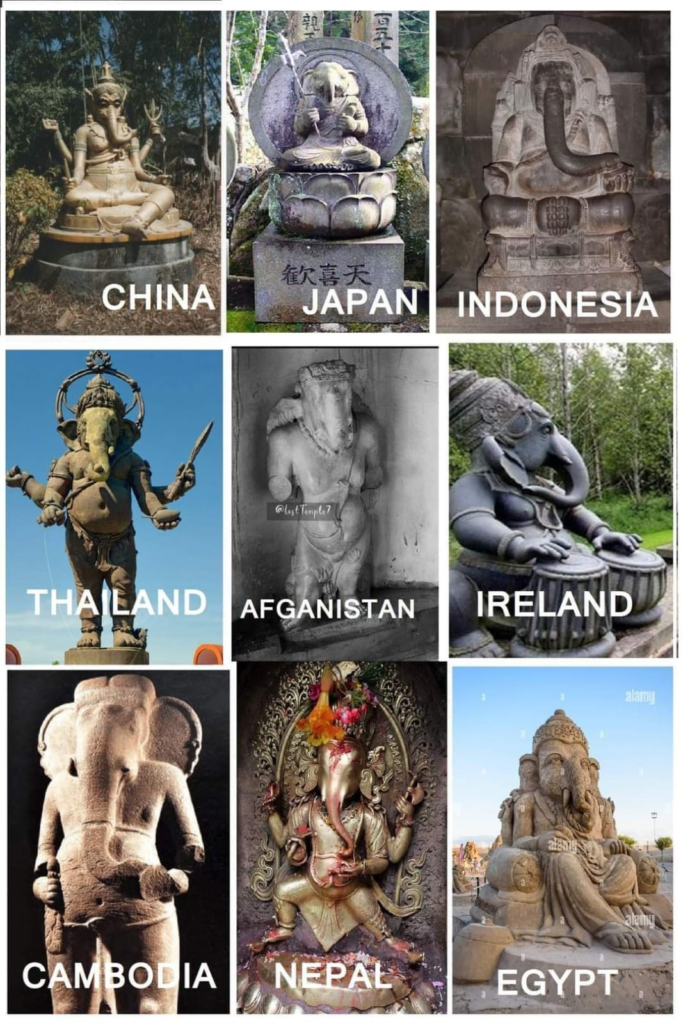Ancient Ganesha Temples Around the World
Lord Ganesha, the elephant-headed god of wisdom, success, and new beginnings, is one of the most revered deities in Hinduism. While his worship originated in India, his divine presence can be felt across the globe, often in unexpected places. This article explores ancient Ganesha temples and shrines in various countries, highlighting the widespread influence of Hindu culture and the deep, enduring appeal of Ganesha beyond India’s borders.
A Journey Through Time and Cultures
China: The Ganesha Temples of Quanzhou
Quanzhou, a historic port city in southeastern China, was once a major center for trade and cultural exchange between China and South Asia. Archaeological excavations have uncovered several Hindu deities’ statues, including Lord Ganesha, dating back to the 8th-10th centuries. The discovery of these statues in the Kaiyuan Temple complex and the Quanzhou Maritime Museum reveals the presence of Hindu merchants and settlers in medieval China. These Ganesha statues, often found alongside Buddhist and Taoist imagery, illustrate the religious diversity of the region during the Tang and Song dynasties.
Japan: Kangiten Temples
In Japan, Lord Ganesha is known as Kangiten or Binayaka-ten, revered as the deity of bliss, joy, and good fortune. Temples dedicated to Kangiten are spread across Japan, with the most prominent being the Hōzan-ji Temple on Mount Ikoma, near Osaka. Built in the 17th century, the temple is unique in that it worships a dual form of Ganesha, depicted as an embracing couple, symbolizing the union of opposites. Another notable temple is the Matsuchiyama Shoden Temple in Tokyo, dating back to the 6th century. The Japanese adaptation of Ganesha emphasizes harmony and prosperity, reflecting the syncretic nature of Japanese spirituality, which blends Shinto, Buddhist, and Hindu traditions.
Indonesia: Candi Ganesha at Prambanan
Indonesia, particularly the island of Java, is home to several ancient Ganesha temples. One of the most famous is the Candi Ganesha at the Prambanan Temple complex, a UNESCO World Heritage site in Central Java. Built in the 9th century, Prambanan is a vast Hindu temple complex dedicated to the Trimurti – Brahma, Vishnu, and Shiva. Within this complex, Ganesha is enshrined in several temples, including Candi Ganesha, where he is depicted seated in a meditative pose, representing wisdom and knowledge. The presence of Ganesha in Indonesian temples reflects the deep-rooted influence of Hinduism in the region before the rise of Islam.
Thailand: Phra Phikanet Shrines
In Thailand, Ganesha is known as Phra Phikanet, revered as the remover of obstacles and the patron of arts and sciences. Ancient shrines dedicated to Phra Phikanet can be found throughout Thailand, especially within the royal temples of Bangkok. One such shrine is located in Wat Phra Kaew, the Temple of the Emerald Buddha, within the Grand Palace complex. The temple, built in the 18th century, houses a small Ganesha shrine that signifies the harmonious blend of Hindu and Buddhist practices in Thai culture. Ganesha’s presence in Thailand, where he is associated with creativity and prosperity, underscores the syncretism and shared heritage of the region’s religious traditions.
Afghanistan: Hindu Shahi Ganesha Relics
Afghanistan, now a predominantly Islamic country, was once a thriving center of Hindu and Buddhist cultures. During the reign of the Hindu Shahi dynasty (9th-10th centuries), numerous temples and statues dedicated to Hindu deities, including Ganesha, were constructed. In the Kabul Valley, archaeological excavations have revealed Ganesha statues and relics, such as the famous bronze Ganesha statue discovered near the city of Kabul, dated to the 7th-8th century. These remnants highlight the region’s historical religious diversity and the influence of Hindu culture along the ancient Silk Road.

Ireland: The Dublin Ganesha Idol
Although Ireland is not traditionally associated with Hinduism, a fascinating discovery of a small Ganesha idol was made in Dublin in the early 20th century. The idol, believed to have been brought to Ireland by British colonial officials or traders returning from India, is an example of how Hindu artifacts made their way to Europe during the colonial era. While not housed in a temple, the Ganesha idol has found its way into several Irish private collections and museums, symbolizing the cross-cultural connections between the East and West.
Cambodia: Ganesha at Angkor Wat
Cambodia, home to the magnificent Angkor Wat temple complex, also harbors ancient temples dedicated to Lord Ganesha. In the 12th-century Angkor Wat and the nearby Angkor Thom, images of Ganesha can be found carved into the temple walls, representing his significance in the Khmer Empire’s Hindu-Buddhist traditions. The depiction of Ganesha alongside other Hindu deities like Vishnu and Shiva illustrates the rich syncretism that characterized Khmer religious practices, blending Hinduism with Mahayana Buddhism.
Nepal: Chobar Ganesh Temple
Nepal, with its unique blend of Hinduism and Buddhism, has several ancient Ganesha temples. One of the oldest is the Chobar Ganesh Temple, located near Kathmandu. Believed to date back over a thousand years, the temple is a significant pilgrimage site for Hindus in Nepal. The temple is associated with numerous legends, including the story of how the valley of Kathmandu was drained by Lord Manjushree, a form of Ganesha, allowing human settlement. Ganesha, known locally as “Ganapati,” is widely worshipped throughout Nepal, and his temples are integral to Nepalese culture and spirituality.
Egypt: Traces of Ganesha in Alexandria
Although Egypt is not known for Hindu temples, there have been reports of ancient Hindu artifacts, including a Ganesha statue, found in Alexandria, Egypt’s historic port city. These artifacts are believed to have been brought by Indian traders or travelers who sailed to Egypt via the Red Sea, a significant trade route in ancient times. While no formal Ganesha temples have been found in Egypt, these discoveries point to the presence of Hindu culture and the connections forged between ancient India and the Mediterranean world.






